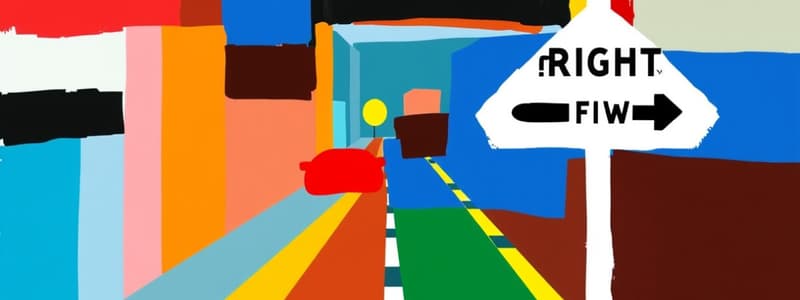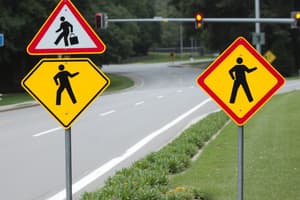Podcast
Questions and Answers
When must a driver yield the right of way when making a right turn?
When must a driver yield the right of way when making a right turn?
- When there is a stop sign
- Only if there are no pedestrians
- When the light is green
- After a complete stop at a red light (correct)
What should a driver do when they encounter red flashing lights?
What should a driver do when they encounter red flashing lights?
- Speed up to get through it
- Only stop for other vehicles
- Yield to pedestrians (correct)
- Ignore the light
When can a driver make a left turn on a red light?
When can a driver make a left turn on a red light?
- From a one-way street to another one-way street with traffic moving to the left (correct)
- Only if there are no other cars
- Whenever the light is red
- At any controlled intersection
What should a driver do at a four-way stop intersection?
What should a driver do at a four-way stop intersection?
When must a driver yield at an uncontrolled intersection?
When must a driver yield at an uncontrolled intersection?
What should a driver do when entering an intersection with a flashing yellow arrow?
What should a driver do when entering an intersection with a flashing yellow arrow?
What must a driver do when coming out of an alley or driveway?
What must a driver do when coming out of an alley or driveway?
A driver may not enter an intersection unless there is enough space to allow passage of other vehicles or pedestrians.
A driver may not enter an intersection unless there is enough space to allow passage of other vehicles or pedestrians.
How far before turning should a driver signal in a business or residential area?
How far before turning should a driver signal in a business or residential area?
What is true about U-turns in relation to visibility?
What is true about U-turns in relation to visibility?
Match the scenarios with the correct yield situation:
Match the scenarios with the correct yield situation:
Flashcards are hidden until you start studying
Study Notes
Right of Way Regulations
- Drivers must yield to pedestrians and other vehicles in various scenarios.
- Right turns on red are permitted after a complete stop, yielding to others.
- Red flashing lights indicate drivers must yield to pedestrians without stop signs.
- Left turns on red are allowed from one-way streets to another, requiring a stop first.
- At four-way stops, the first driver to stop is the first to go; if two vehicles arrive simultaneously, the vehicle on the left yields to the right.
- Flashing yellow arrows signal that drivers must yield when entering an intersection.
- In uncontrolled intersections, the vehicle on the left must yield to the one on the right.
- Left-hand turns into oncoming traffic must yield to any opposing vehicles, even if the light turns red.
Merging and Intersections
- Approach a MERGE sign by adjusting speed as necessary to prevent collisions.
- When exiting alleys or driveways, drivers must wait for oncoming traffic to clear.
- At "T" intersections without traffic controls, yield to crossing traffic.
Emergency Vehicles
- Always yield to emergency vehicles showing audible and visual signals.
Driver Responsibilities
- Do not enter intersections or crosswalks unless space is clear for other vehicles and pedestrians.
- Avoid driving on railroad crossings.
- After passing another vehicle, wait for it to be fully visible in the rearview mirror before re-entering the right lane.
Passing Regulations
- A safe distance for passing must be maintained, staying at least 200 feet from oncoming vehicles.
- The vehicle being passed must not increase speed until the passing maneuver is complete.
- Flashing turn signals for courtesy or "do pass" is illegal.
- No-passing zones exist near curves, hills, railroad crossings, bridges with obstructed views, tunnels, and while a bus is loading.
Lane Usage
- Passing in a two-way lane is prohibited where marked by solid yellow lines or "DO NOT PASS" signs.
- Signals must be given at least 100 feet before turning in residential or business areas.
Hand Signals for Turning
- Right turn: Left hand raised.
- Left turn: Left hand parallel to the ground.
- Stop or slow down: Left hand shaped in an upside-down "L".
U-Turn Regulations
- U-turns are disallowed on curves and hills unless visibility of at least 500 feet in all directions is available.
- Municipalities may create laws to prohibit U-turns in certain areas.
Parking and Hill Parking
- When parking on a hill, engage the parking brake and gear select in park mode.
- Wheel placement when parking:
- Downhill: Turn wheels to the curb.
- Uphill with curb: Turn wheels away from the curb.
- Uphill or downhill without curb: Turn wheels to the right.
Prohibited Parking Areas
- Do not park within 15 feet of a fire hydrant or within designated distances from marked zones.
Studying That Suits You
Use AI to generate personalized quizzes and flashcards to suit your learning preferences.




